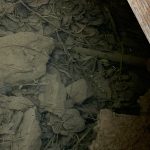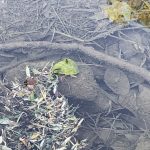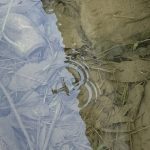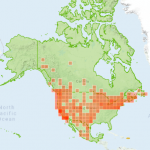Species Summary extra credit
The weather on the day that I did my species summary was a bit colder in temperature. It felt about 60 degrees Fahrenheit. There was a slight breeze of a wind, but it is was a very faint breeze. It was sunny with no clouds in the sky. And I was observing the organism in the creek near my sit spot.

Multiple Water Striders under a bridge

Two water striders on a leaf
I decided to observe an insect the lives on the surface of the water, and glides along the surface. They have big bodies and thin long legs that they use to push them to where they need to go. They have two antlers at their head, and their back legs start to go at an angle at the back. The bodies are a grayish color, and while was observing them it seems liked they had antlers in the prompt to put the upper half of their body about the water. After observing the organism, it looked like they travel in groups ,that I was observing about 20 organisms of the same species. They tend to swim again the current, but they will try to rest against rocks and leaves, most likely to save energy that it would take to constantly swim against the current.

A water strider making ripples, and camouflaging with the surface of the creek
They also tend not to get close to other organisms, even each other, the closet one I saw was two water striders get within 1 centimeter of each other. When they get close to each other they will swim away from each other. The color of their body tends to blend in very well with the color of the rocks on the surface at the bottom of the creek. Some were smaller than other, so I assumed that these smaller organisms were the young/juvenile offspring of the organism. Majority of these organisms stayed under the bridge, mainly the smaller organisms. I also saw that if they were not trying to stay still by laying on rocks and leaves, they like deeper waters.
Natural History

Population of the water striders over the years

Map of where water striders are common/native to
The organism I observed was identified as the Aquarius Remigis, of more commonly known as the common water strider. They are a part of the Genus Aquarius family, which is a family of insects that are all different types of water striders. They are native to Northern America and part of Central America, but they are seen the most in the United States and Canada, but there have also been findings of this species in Mexico and Puerto Rico. (Aquarius remigis) Naturally they tend to live in river and streams in the eastern half of the United States. (Species Aquarius remigis)

Activity of the water striders over a year
They will usually move a lot to avoid being easy prey, and they will also use their front legs to capture prey. ( Common Water Strider) For their food they will usually eat mosquito larvae that live under the surface or on any dead insects or insects that accidentally landed on the surface. (Common Water Strider) During breeding season, they will communicate with potential mates by making ripples on the surface on the water. (Common Water Strider) Adult females also normally lay their eggs on any plant stems that are located by the edge of the water. (Common Water Strider) They also are more abundant during the summer and spring compared to any other time of the year, and they are also growing rapidly over the years. (Common Water Strider)
References Cited
Aquarius remigis (Say, 1832) in GBIF Secretariat (2019). GBIF Backbone Taxonomy. Checklist dataset https://doi.org/10.15468/39omei accessed via GBIF.org on 2020-10-07.
Common Water Strider (Aquarius remigis). iNaturalist. https://www.inaturalist.org/taxa/59651-Aquarius-remigis.
Species Aquarius remigis. BugGuide.Net. https://bugguide.net/node/view/114657/bgi.

Leave A Comment
You must be logged in to post a comment.